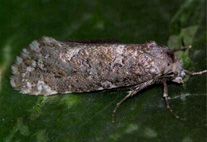Abstract
Ninety-one species of pelagic decapod shrimp were identified in 938 midwater-trawl collections taken between 1963 and 1974 from the North and South Atlantic. Distributional maps are provided for the most frequently occurring species. Nighttime abundance of most species was greatest within the upper 200 m. Degree of geographical overlap was estimated using the geometric mean of the proportion of joint occurrences with a value ≥ 0.5 deemed significant. Geographical distributions tended to be unique, and only 31 species had values ≥ 0.5 with one or more other species. Species within genera and within phylogenetic subgroups of Sergia were generally parapatric or partially overlapping in distribution. Five geographical groupings of co-occurring species across genera were identified: Subpolar-Temperate, Southern Hemisphere, Central, Tropical, Eastern Tropical and Western Tropical. The two species of the Southern Hemisphere group are circumpolar at temperate latitudes. The 12 species of the Central group occurred throughout the subtropical and tropical North and South Atlantic. The eight species of the Tropical group occurred broadly across the equatorial Atlantic and Caribbean with ranges usually extending into the Gulf of Mexico and northward in the Gulf Stream. The two species of the Western Tropical group occurred most often in the western tropics, but there were scattered occurrences at subtropical latitudes. The four species of the Eastern Tropical group were endemic to the Mauritanian Upwelling and the Angola-Benguela Frontal zones off western Africa. Two of the three species in the Subpolar-Temperate group had bipolar distributions, and all three occurred in the Mediterranean and in the Mauritanian Upwelling zone. Most Central, Tropical and Western Tropical species were present in the in the Gulf of Mexico. The 10 species from the Mediterranean were a mixture of Subpolar-Temperate, Central and benthopelagic species. Patterns of distribution in Atlantic pelagic decapods closely parallel those of other pelagic taxa, but myctophid fishes from the same collections appear to partition subtropical regions more finely.

